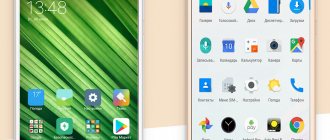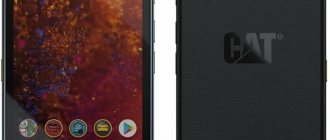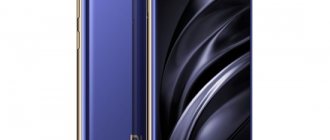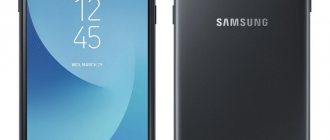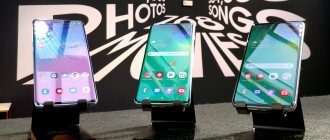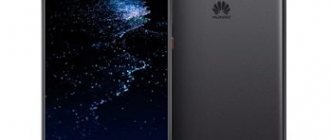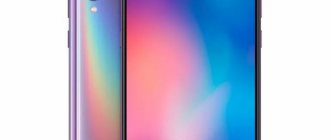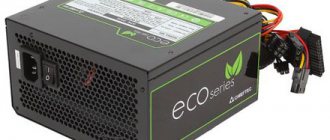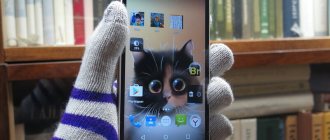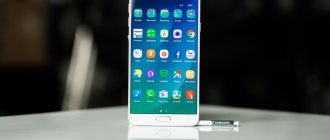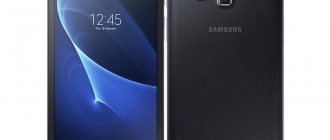Phablet: what is it?
Phablet is an English word that appeared by combining two others: phone and tablet.
The idea was to create a device that would be a cross between two gadgets - a smartphone and a tablet computer. Currently, the following situation can be observed in the mobile device market: phones and laptops practically do not differ in hardware and technical support. Basically, the difference can only be observed in the design of the case, battery capacity and display size. Based on this, we can conclude that tablets are scaled smartphones. Phablets are another category. Let's take a closer look at their affiliation. It is customary that gadgets that are primarily intended for making calls are produced with a diagonal of 3-5 inches. Tablets, in turn, mostly have 10-12-inch screens. And the segment between them (6-9ʺ) was filled with phablets.
General concept
The term "phablet" comes, of course, from English by merging two other words - phone (telephone) and tablet (tablet). It turns out that this term means something between a regular smartphone and a tablet computer for full-fledged work.
It’s just that the situation in the device market is such that in terms of hardware, mobile phones and computers now differ little. The main difference is in the size of the display, body and battery: tablets are simply "scaled" phones. It’s just that if initially smartphones were produced with a display size of 3-5 inches, and tablet computers with 10-12 inches, then over time the gap of 6-9 inches was filled by that same phablet. What it is, now you probably understand.
How to understand that you have a phablet in your hands
It’s worth noting right away that a phablet can be very similar to a smartphone or a tablet, depending on what case design the manufacturer has made for it. Therefore, it often happens that it is incredibly difficult to distinguish a phablet from the gadgets we are used to. But this is difficult only initially, but if we know the basic parameters that distinguish a modern phablet from a smartphone or tablet, then it will be much easier to recognize a tablet phone in our hands.
A phablet is the middle link between two types of gadgets that are very similar to each other - a smartphone and a tablet. At its core, the phablet is a kind of hybrid of these two devices. It has in its parameters the main features of both a smartphone and a tablet. Today, a phablet is considered to be a device that has a screen with a diagonal of 5.5″ to 6.9″. Most often, having a large diagonal, when compared with a smartphone, the phablet does not look massive and in its physical dimensions is only slightly larger than the average smartphone with screen diagonals, for example, 5.2″ or 5.5″.
In addition, a modern phablet is a fairly powerful device. Very often we can find various models of this type of device that correspond to the parameters of flagships or the premium segment. It is worth understanding that the concept of phablet is quite relative and can be applied to many modern smartphones that have only recently appeared on our store windows. Some of the most striking examples of this are the popular Galaxy S8 and S8+, as well as the LG G6. Although we are accustomed to considering these models as smartphones, they nevertheless fully correspond to the characteristics and description of the phablet.
While many phablets bear uncanny resemblance to smartphones, other models are difficult to distinguish from tablet computers. But, despite the incredible similarities, the phablet still has many differences, and we will look at them further.
Huawei Mate 20 X (2018)
- Diagonal: 7.2 inches.
- Dimensions: 174.6x85.4x8.2 mm.
- Weight: 232 grams.
It would be a crime to finish this collection without mentioning the real monster from Huawei. The flagship Mate 20 X, released in 2020, can easily be called the most interesting smartphone of the year, because its 7.2-inch screen did not and does not fit into any framework. In its home country, China, the Mate 20 X was a particularly resounding success. This is evidenced by the fact that the 5G version of the smartphone, released a year later, collected more than a million pre-orders in one day. Unlike the devices listed above, the Mate 20 X is still on sale in stores, so lovers of particularly large smartphones still have a chance to buy this pocket media center. Although... I definitely wouldn’t dare put such a giant in my jeans pocket.
The best phablets
Xiaomi Mi Max 2 64Gb
It is one of the best offers on the market. The device has an impressive 5300 mAh battery and a 6.3-inch screen diagonal. The phablet turned out to be quite thin, only 7.6 mm. The Qualcomm Snapdragon 625 processor is responsible for stable and uninterrupted operation. Memory is also not deprived, the user has 4 GB of RAM and 64 GB of internal memory, plus there is support for SD cards. Among the nice additions are USB Type-C charging and fast charging function.
Main parameters:
- Screen diagonal: 6.44 inches;
- screen resolution: 1920×1080;
- weight: 211 g;
- number of SIM cards: 2;
- processor: Qualcomm Snapdragon 625;
- memory capacity: 64 GB;
- RAM capacity: 4 GB;
- battery capacity: 5300 mAh;
- camera: 12 MP;
- memory card support: yes;
- support for 4G networks: yes;
- average price: 10450 – 16999 rub.
Samsung Galaxy Note 8 64GB
The device belongs to the flagship line of its company. The smartphone has almost no analogues, all due to the fact that a special stylus for controlling the phone is hidden inside the case. This smartphone has almost all modern functions, such as: protection from moisture and dust, a fingerprint scanner, an excellent rear camera, and an eye unlock system.
Characteristics:
- Screen diagonal: 6.3 inches;
- resolution: 2960×1440;
- weight: 195 g;
- number of SIM cards: 2;
- processor: Exynos 9 Octa 8895;
- memory capacity: 64 GB;
- RAM capacity: 6 GB;
- battery capacity: 3300 mAh;
- main camera: dual 12/12 MP;
- memory card support: yes;
- support for 4G networks: yes;
- cost: 35450 – 59990 rub.
OnePlus 5T
Another update of the company's flagship line. The size of the device has remained almost unchanged. However, hidden inside is the most powerful filling that was available at the time of the smartphone’s release. Compared to its predecessor, the new model has increased the diagonal to 6 inches by reducing the frames around the screen. In addition, the phone received an unlocking function using face identification.
Smartphone parameters:
- screen diagonal: 6 inches;
- resolution: 2160×1080;
- weight: 162 g;
- number of SIM cards: 2;
- processor: Qualcomm Snapdragon 835;
- memory capacity: 64 GB;
- RAM capacity: 6 GB;
- battery capacity: 3300 mAh;
- main camera: dual 16/20 MP;
- memory card support: no;
- support for 4G networks: yes;
- price: 27490 – 41990 rub.
Huawei P20 Pro
Another crown of technology from Huawei. The model has an excellent screen that occupies the entire front panel of the phone, leaving space only for sensors. The smartphone also acquired a revolutionary camera with three sensors, which is what sets this device apart from others. It is also endowed with wide functionality, ranging from a five-fold camera zoom to dust and moisture protection. The battery size is 4000 mAh, this reserve is enough for a whole day of active use, and the Super Charge fast charging function is also a nice addition.
Main characteristics:
- smartphone with Android 8.1;
- support for two SIM cards;
- screen 6.1″, resolution 2240×1080;
- dual camera 40/20 MP, laser autofocus, F/1.8;
- memory 128 GB, without memory card slot;
- RAM capacity 6 GB;
- battery 4000 mAh;
- HiSilicon Kirin 970 processor;
- smartphone: 38,990 – 54,990 rub.
Apple iPhone X
Apple is once again setting the trend for smartphones in 2020 with the introduction of a new iPhone model. The new model for the first time received a frameless screen, abandoning the well-known “Home” button. The phone lies in the hand much more pleasantly than its Apple predecessors; this was achieved by rounding the corners and excellent optimization of its operating system for the new device format. It is not surprising that the new creation also received the best components. It’s hard not to mention Face ID, yes, this function has long been implemented on smartphones of past years, but it was Apple that brought it to stable and correct operation in any lighting. Pleasant additions to the Apple flagship are support for wireless charging and a dual rear camera that amazes with its shooting quality.
Options:
- smartphone with iOS 11;
- screen 5.8″, resolution 2436×1125;
- dual camera 12/12 MP, autofocus, F/1.8;
- memory 64 GB, without memory card slot, RAM 3 GB;
- 3G, 4G LTE, LTE-A, Wi-Fi, Bluetooth, NFC, GPS, GLONASS;
- Apple A11 Bionic processor;
- number of processor cores 6;
- price: 57880 – 54700 rub.
Samsung Galaxy S20 Ultra (6.9“)
Price: from 69,000 rubles
S20 Ultra is the best flagship of the Korean manufacturer in 2020. It costs a lot, but its capabilities are incredible. The device received a huge 6.9-inch AMOLED screen with a resolution of 3200*1440, a refresh rate of 120 Hz, AlwaysOn and HDR10+. The display here is “leaky”, the front camera resolution is 40 MP, the fingerprint sensor is also installed in the matrix. All this is covered with Gorilla Glass 6. The back panel has an impressive camera unit, which in its appearance hints at serious capabilities. It consists of three lenses and a depth sensor. The main sensor is 108 MP, equipped with optical stabilization, secondary sensors are 12 MP wide angle with optical stabilization and 48 MP telephoto with 4x optical zoom and 100x digital zoom. In addition, the camera can shoot video in 8K.
In addition to a huge display and an excellent camera, the phone has stereo sound, IP68 water protection, a capacious 5000 mAh battery with fast, wireless and reverse charging, and a full set of wireless modules. Performance is represented by the proprietary Exynos 990 chipset and memory up to 16/512 GB. Unlike many competitor flagships, there is support for memory cards, but the slot is combined. There is no headset jack.
Another Samsung smartphone with a similar screen is the Note 20 Ultra. As before, it is aimed at the business segment, has stylus support and related functions. The model differs in camera and has a less capacious battery. The price tag of the Note 20 Ultra at the time of writing this selection starts from 100 thousand rubles.
How to design for phablets
So, Samsung Galaxy Note was the first phablet on the market, but the best thing it could offer users to facilitate interaction was the stylus. Of course, it helps, but it still remains an additional tool that not everyone likes.
Another solution to the above problem was proposed by Luke Wroblewski. In his opinion, it is worth placing the most important UI elements at the bottom of the screen, and the least important ones at the top. This strategy works well for iOS apps, but it doesn't work well for Android because phablets like the Google Nexus 6 have a control panel at the bottom of the screen that will compete with the most important elements of your app.
Conclusion
Phablets are certainly shaping the way we consume digital content and, as a result, influencing design for mobile devices. More up-to-date research and data on mobile device usage is needed to make using phablets as convenient as using small smartphones. It's a big challenge for UX designers to find the most natural and comfortable way to use phablets.
Author of the article Armen Ghazarian
Translation – Duty room
See also:
Samsung phablets
Since our article is devoted to medium-sized devices - phablets with a screen of 6-9 inches, we will try to give examples of the most successful models that you should pay attention to. And let's start, perhaps, with one of the top manufacturers of electronic devices - the Korean company Samsung.
The manufacturer has several models in its line that can be classified as this class of devices. In particular, this is the Samsung Galaxy Note (which has several generations of models at once, because there are Note 2, 3, 4). These are phablets in their classic form, since they have the characteristics of a tablet, but are capable of making calls and have a relatively small screen size. In contrast, another model - the Galaxy Tab Pro 8.4 - is simply a giant, but also a device that can be classified in this class. Its screen diagonal is 8.4 inches.
As the popularity of Note models shows, phablets are quite in demand. This is confirmed by sales of devices from other manufacturers that belong to the same class. And in general, there are more and more gadgets with screen sizes of 6-9 inches on the market. Even this can be called a clear indicator of their popularity and demand.
Notes
- ↑ [https://www.oxforddictionaries.com/definition/english/phablet phablet], oxforddictionaries.com (English)
- [https://www.multitran.ru/c/m.exe?a=3&s=tablet&sc=371&l1=1&l2=2 tablet], multitran.ru (Russian)
- [https://www2.deloitte.com/content/dam/Deloitte/global/Documents/Technology-Media-Telecommunications/gx-tmt-2014prediction-phablets-are-not-a-phad.pdf Deloitte. Phablets are not a phad] (English)
- Segan, Sasha
. [https://www.pcmag.com/slideshow/story/294004/enter-the-phablet-a-history-of-phone-tablet-hybrids Enter the Phablet: A History of Phone-Tablet Hybrids] (02/13/2013 ). (English) - [https://www.trademarkia.com/phablet-85456668.html PHABLET - Reviews & Brand Information - LG Electronics Inc. Seoul 150-721, - Serial Number: 85456668] (10/26/2011). Retrieved January 31, 2013. [https://www.webcitation.org/6EBNQp88m Archived from the original on February 4, 2013]. (English)
- [https://stadium.weblogsinc.com/engadget/distro/022213_DISTRO_book.pdf The Rise of the Ever-Expanding Smartphone Screen]. Engadget, Distro Issue 79, p. 50, Jon Fingus (02/22/2013). (English)
- Wagstaff, Jeremy; Yee, Lee Chyen (01/07/2013), [https://www.reuters.com/article/2013/01/07/us-phablets-idUSBRE9050CS20130107 Handset makers scurry to join Year of the Phablet]
, Reuters, (eng. ) - Jarah Euston (09/08/2014), [https://www.flurry.com/blog/flurry-insights/tides-turn-phablet%E2%80%99s-popularity The Tides Turn for the Phablet's Popularity]
, Flurry, . Retrieved September 28, 2014. (English) - [https://www.techradar.com/news/phone-and-communications/mobile-phones/the-10-best-phablets-in-the-world-today-1251016 techradar.phones: The 10 best phablets in the world today] (English)
- [https://www.cnet.com/products/apple-iphone-6-plus/ Apple reveals iPhone 6 Plus with 5.5-inch screen, starts at $299 (hands-on)], CNET (09.09.2014). Retrieved September 12, 2014. “The larger iPhone is basically a phablet, or phone-tablet, like other big phones such as the 5.7-inch Samsung Galaxy Note 4.” (English)
- [https://vido.com.ua/article/8688/galaxy-tab-pro-8-4-lte-samyi-bolshoi-fabliet-ot-samsung/ Galaxy Tab Pro 8.4 LTE is the largest phablet from Samsung]. vido.com.ua. Retrieved July 27, 2020.
UMIDIGI S2 Lite
This noname phablet from a Chinese manufacturer is UMIDIGI S2 Lite. In terms of price/performance ratio, it beats almost all of its competitors. So, what's good about this phablet?
- Firstly, it has a powerful 5100 mAh battery. Its charge is enough for 2.5-3 days of active use of the smartphone. And if you turn on screen brightness saving, it will last 4 days on a single charge.
- The huge 6-inch screen is not limited by a frame; it seems to flow around the smartphone, making the image higher quality and more voluminous. The screen is protected by 4th generation tempered glass – Gorilla Glass 4. Theoretically, the screen is even resistant to scratches from sharp metal objects (nails, needles, etc.), but I don’t recommend checking it here.
- Dual 16MP + 5MP camera and front camera for selfies.
- The metal case increases the smartphone's resistance to damage and falls from a small height. Plus, you get the feeling that you are holding in your hand a truly worthwhile thing, and not just another Chinese craft.
- The latest facial recognition technology.
- And of course, the smartphone is equipped with a bunch of additional sensors: electronic compass, gyroscope, GPS, pressure and light sensors, proximity sensor.
Even though this smartphone does not have the most powerful processor and is far from flagships in terms of RAM size (4 GB of memory on board), the screen resolution is not the highest, but all these “disadvantages” turn into advantages when it comes to energy efficiency. You won't be charging this smartphone every day like most people do. It will work for 3 days on a new battery, and you won’t even notice a loss in performance in games or when watching videos on YouTube.
How to choose the right phone
Android or iPhone? Android phones offer smartphones in a wide price range. However, iPhones offer fast software updates, games and apps, as well as security and privacy. Watch our confrontation between iPhone and Android.
Screen size
For those who want to try a phablet, we advise you to choose a phone from 6 inches. The largest phones range from 6.5 to just under 7 inches. If you want something you can easily use with one hand, get one of the phones with a screen under 6 inches.
Cameras
Ignore the megapixel count. Instead, check out comparisons of the cameras on the phones you're interested in. Also look for special features like night mode to get better quality in low light.
Battery life
Typically, phones with larger batteries (measured in mAh) offer the longest battery life, but this is not always the case. That's why we run our own custom battery tests, where phones reload web pages using mobile data, with display brightness set to 150 nits.
What is it, the ideal choice of many
In fact, it is impossible to single out the best phablet. Here, as with any other comparison, the human factor still remains a compelling argument. We are all different. Some people prefer sleek phones from a reliable manufacturer. Others cannot afford a branded device, and they unwittingly become the owners of a budget model. Still others, practical representatives of humanity, opt for a device that meets their optimal needs.
As a rule, in the latter case, the desired quality still depends on the financial capabilities of the person. Therefore (for the sake of practicality), the main emphasis in the article is on inexpensive modifications of the specified type of device.
Story
The word "phablet" is a borrowing from English. phablet
- the result of adding the words
phone
phone and
tablet
tablet. A stable Russian-language term is plafond, pla(nsheto) - (tele)fon, also due to the similarity of the device’s form factor with the plafond of lighting in transport.
At various times, devices were released that PC Magazine mentioned as predecessors of the phablet:
- - a prototype of the “first real phablet”, which is a tablet PC with a built-in cellular modem for data transfer. It can only be conditionally called the progenitor of today's phablets, because. the model did not have the main distinguishing feature of phablets - it did not allow making a voice call using the device as a telephone, i.e. putting it to your ear.
- (screen 5.0 inches)
- (7.0 inch screen)
- (screen 5.0 inches)
In 2011, several devices appeared at once:
- Samsung Galaxy Player 5 (5.0 inch screen)
- Pantech Pocket
- Samsung Galaxy Note (5.3-inch screen, graphics tablet)
On October 26, 2011, the South Korean company LG Electronics filed an application to register the word phablet
as an independent brand. A decision on the application was expected by February 2013.
The word “phablet” began to be used online even more often after the publications of the popular publication Engadget and the Reuters agency, which predicted that 2013 would be the year of the phablet.
In 2013, many phablet models appeared, and, according to company estimates, by the fall of 2014 they accounted for about 10% of all mobile devices (phones, smartphones, phablets, small and large Internet tablets), instead of 2% in 2013.
Lenovo, Asus and others
For example, we all know that the Chinese concern Lenovo is positioned primarily as a player in the budget class due to a large number of such models. Although, of course, there are also expensive flagships among them.
When it comes to Lenovo phablets, the first model that comes to mind is the K3 Note. It is multifunctional, has a screen diagonal of 7.6 inches and costs only $145. If you don’t want to pay for the promotion of the Samsung brand, you can take Lenovo.
Another example is Asus products. This manufacturer has many of its own phablets, which have a diagonal of 7-8 inches. Moreover, the buyer also has a choice - buy a more affordable, but simpler in functionality PhonePad, or pay a little more for a 7-inch tablet with one of the most powerful hardware on the budget Nexus 9 device market.
In addition to Asus and Lenovo, you can find models from other companies on sale. For example, HTC, LG, Huawei and Meizu also offer a good selection of such devices.
Apple in the phablet market
You may ask, what about the world leader, the product giant Apple? Do they have anything?
Certainly! The new 5.5-inch iPhone 6 Plus is a typical phablet. The device looks quite large compared to the regular 6th version, but at the same time has expanded capabilities due to a larger display. It should be noted that this product is somewhat innovative for the company, since Apple has not previously competed with Samsung in the market for devices with a screen larger than 4.5 inches. Now, obviously, the American company is testing the waters where the Korean company has been leading for many years.
How is a phablet similar to a smartphone?
The main similarity between the two devices, a phablet and a smartphone, is that with the help of both one and the other we can make phone calls. The procedure for this function is absolutely identical in both cases, because, just like in the case of smartphones, most phablets run on the Android operating system. The rest of the functionality of the phablet is as wide as that of smartphones. With the help of a phablet, we can take photos, shoot videos, communicate with our loved ones via instant messengers, send text messages, play our favorite mobile games, and so on.
It often happens that the shape of a phablet is very similar to a smartphone. In other words, a phablet is essentially an enlarged smartphone and nothing more. And perhaps only the size of this gadget only slightly reminds us of its additional similarity to a tablet
Another significant similarity between the two devices is that when choosing a brand new phablet for ourselves, we pay attention to exactly the same parameters as if we were choosing a smartphone. We also look at processor performance, the amount of built-in and internal memory, camera characteristics, and so on.
Smartphone
A smartphone is a class of mobile device with computer-like functionality. These devices are equipped with an advanced mobile operating system and have a platform for application developers.
There are two main smartphone platforms in use today: Android (from Google) and iOS (from Apple). An application written for a specific platform can usually run on any smartphone using the same platform.
Smartphone apps are also faster and better integrated with the phone's user interface than Java apps. Smartphones have larger displays and faster processors than so-called feature phones or silent phones.
The smartphone is equipped with phone call, SMS, web browsing, media player, video game and so on. Smartphones are usually pocket-sized and usually have different screen sizes, ranging from 3 inches to 5 inches, such as the Samsung Galaxy Mini, Motorola RAZR and similar products.
Samsung Galaxy Note 8 is the best
- Display: 6.3 inches, 29601440 pixels;
- Processor: eight-core Snapdragon 835 from Qualcomm;
- Main camera: dual (12 MP + 12 MP);
- Front camera: 8 MP;
- RAM: 6 GB;
- Storage: 64 GB;
- Battery capacity: 3300 mAh.
Cost: from 44,800 rub.
Samsung Galaxy Note 8 is a phablet that has virtually no weak points. A powerful processor, high-quality display, protection from dust and moisture, a number of unique functions, not to mention the fact that this is one of the first devices from the Korean brand with a dual camera. It is not surprising that this smartphone received a lot of positive reviews from market experts and was warmly received by authoritative publications.
The most interesting feature of the Galaxy Note line is, of course, the S Pen, and in the new Note 8 it has received many new features. Now you can use the S Pen to create not only texts and images, but also animations. Moreover, since transferring GIFs through instant messengers and social networks is difficult due to restrictions on the size of the sent file, Samsung had to take on this problem.
The solution turned out to be simple and elegant - all Galaxy Note 8 owners can upload their animations to the PENUP service specially created for them, which allows them to share files with users of other resources.
Advantages:
- Not a bad camera;
- S Pen support;
- High-quality display with rounded edges;
- Large amount of RAM;
- Protection from dust and moisture;
- Interesting design.
The best big phones of 2020
What are the best big phones Samsung's new Galaxy Note 20 Ultra, with its massive 6.9-inch display, tops our list of big-screen giants. This is a flagship phablet with a triple camera, a super powerful processor, a dynamic refresh rate of 120 Hz and an S Pen stylus .
iPhone fans will naturally look to the iPhone 11 Pro Max as their best option, given its Super Retina XDR , massive power, quality camera, and long battery life.
The only downside to the iPhone 11 Pro is the price, so the 6.1-inch iPhone 11 offers much of what we love about the 11 Pro for $300 less, while the iPhone XR remains an attractive choice, especially now that it's available for $599.
Note
The 6.7-inch Galaxy S20 Plus and 6.9-inch Galaxy S20 Ultra also offer wide displays and advanced multi-lens camera systems with features not found in iPhone phones.
Next comes OnePlus , which has set a new standard of quality between the OnePlus Nord and OnePlus 8 Pro.
We think the Galaxy Note 10 Plus is a phablet worth considering thanks to its design and versatile S Pen stylus.
But if $1,100 for the Note 10 Plus is too much, then how about $250? That's the price of the Moto G Power, which includes a 6.4-inch display and a 5,000mAh battery that will last longer than any other phone.
The operating time was 16 hours and 10 minutes. Most phones work 9 or 10 hours.
Rounding out the list is the Motorola Edge Plus, which rivals Samsung's latest flagships in functionality but costs $200 less than the S20 Plus.
You may also be interested in the article - the best 5G smartphones of 2020.
Definition
The Samsung Galaxy Note series, which popularized the look of the phablet factor.
Fabay's definition has changed in recent years due to the proliferation of large displays on mainstream smartphones, and smartphones designed with thin bezels and/or curved screens to make them more compact than other devices with similar screen sizes. Thus, a device with a "phablet-sized" screen may not necessarily be considered one.
Current phablets typically have a diagonal display measurement between 5.1 inches (130 mm) and 7 inches (180 mm), assuming a 16:9 aspect ratio. By comparison, most flagship smartphones released in 2020 have a screen size of around 5 in (130 mm), with larger versions of mainstream flagships (such as the iPhone 7 Plus, Pixel XL and Samsung Galaxy S7 Edge) using 5.5 in (140 mm) displays. PhoneArena
argued that the S7 edge was not a Fabayet, as it has a narrow and compact build with a physical footprint more in line with the smaller Nexus 5X, largely due to its use of a curved-edge display.
In 2020, some manufacturers began releasing smartphones with displays taller than the usual 16:9 aspect ratio used by most devices, and diagonal screen sizes often around 6 inches. However, in these cases, the device sizes are more compact than a 16:9 aspect ratio device with equivalent diagonal screen sizes.
Samsung Galaxy S8
The number of phablets includes the latest flagships from. The older 6.2-inch Galaxy S8+ model fits especially naturally into this category of smartphones. Almost every detail in this device is good - after all, it is one of the most popular and best-selling smartphones in 2020. The key feature is the curved elongated display with an 18:9 ratio. What else should I add? The phablet has the best cameras on the market, the most up-to-date hardware, and a bunch of different useful features.
- New shell from the manufacturer on top of the latest version of Android
- 6.2-inch AMOLED screen with a resolution of 2960×1440 pixels (pixel density is 531 per inch)
- A pair of the best 12 and 8 MP cameras, ready to take a good photo in any conditions
- Top branded processor or similar performance Snapdragon 835
- 4 or 6 GB RAM (in recent updated version)
- 64 or 128 GB of permanent memory
- 3500 mAh battery
What are the disadvantages of a phablet from Samsung? Firstly, autonomy, which is clearly not the best in the class. Secondly, the rawness of some ideas. One of the best phablets of 2017 supports wireless and fast charging and is equipped with a retinal scanner. In general, an ideal option for those who do not want to put up with the shortcomings of budget smartphones. But you will have to pay about 53,000 rubles for the Samsung Galaxy S8+ (the updated version with 128 GB will cost 58,000 rubles).
Ulefone T2 (6.7“)
Price: from 15,500 rubles
The rather interesting Chinese phablet Ulefone T2 is capable of offering users a 6.7-inch screen with FHD+ resolution and a “monobrow”, which looks quite strange in 2020. However, the model received pretty decent hardware – Helio P70 and 6 GB of RAM. They can even handle running games. 128 GB permanent storage in the device. Security is ensured by a finger scanner on the rear panel or face unlock.
Autonomous operation is represented by a 4200 mAh battery with fast and wireless charging. Cameras - 8 MP on the front and two lenses on the back - 16 and 8 MP. You will be pleased with the modern USB-C connector, NFC and notification indicator. But the downside is the lack of a headphone jack.
Buy
What are phablets?
Unsurprisingly, the word “phablet” came to us from the English language – phablet. It was learned after merging two other concepts - phone (telephone) and tablet (tablet). That is, we conclude that a phablet is a device that combines the qualities of two other devices at once. They are larger than smartphones, but smaller than tablets. However, the sizes of phones classified as phablets are constantly changing. A few years ago, a 5-inch smartphone was already one of them. Today, models of similar dimensions are considered compact, and phablets include solutions with a screen larger than 5.5 inches.
It is also worth noting that gadgets with a diagonal of more than 6.9-7 inches are already considered tablets. It is very likely that this threshold will change soon, as they are actively developing, which allows manufacturers to create huge smartphones that will be comparable in screen size to tablets, but due to the small frames around them, will remain quite compact.
How are phablets different from smartphones? Nothing, really, except larger sizes. How are phablets different from tablets? In addition to their more compact dimensions, in 100% of cases they support work with SIM cards, while many do not have this ability. The tablet market is going through hard times right now, so phablets are very relevant.
If we talk about the advantages of phablets, then we can highlight only one significant one – size. To many, smartphones of this size will seem like “shovels”. For others, it’s an ideal compromise between a smartphone and a tablet. Therefore, the size at the same time is a plus. Otherwise, to highlight the advantages and disadvantages, you need to consider a specific model. What are we going to do now?
Samsung Galaxy S10 5G (6.7“)
Price: from 60,000 rubles
This is the first Samsung smartphone to support 5G. For the most part, it's a standard Galaxy S10, just with additional cameras and a larger 4,500mAh battery.
The huge 6.7" display lets you see every detail in your videos, and you'll appreciate the benefits of longer battery life when you start downloading large files over 5G. Loading is lightning fast: a half-hour video in high quality is downloaded in five seconds. However, energy consumption is increased, and a large battery partially compensates for this. One thing is upsetting: everything that makes the Galaxy S10 5G unique is still useless in Russia.
Buy
Lenovo phablet: excellent quality at an affordable price
Lenovo is a Chinese manufacturer that has long been pleasing domestic buyers with its products. During its activity, the company has earned a good reputation. The line includes both premium and budget models. If you are reviewing the phablet category, then it is worth considering the characteristics of the Phab Plus model. The device has a diagonal of 6.8 inches. Its cost varies within 20 thousand rubles. The gadget is distinguished by its multifunctionality. Powered by a 4-core processor with a frequency of 1.5 GHz. Core type – Cortex-A53. The chipset model is Qualcomm Snapdragon 615. Flawless operation is achieved thanks to 2 GB of RAM. To store information, the user is provided with 32 GB of storage; there is also support for memory cards up to 200 GB, type - microSD. The gadget is equipped with a 13 MP rear camera and a 5 MP front camera. Autonomous operation is provided by a 3500 mAh lithium-ion battery.
Huawei Honor Note 8
Huawei is not far behind the leaders in the phablet market. Moreover, if the previously discussed solutions can be called state employees and middle peasants, then Honor Note 8 deserves the title of a full-fledged flagship. First of all, it is worth noting the display, which is not just huge, but also of high resolution, which provides an excellent picture. The phablet is equipped with powerful hardware, and one of the features is the presence of an NFC interface.
- A proprietary EMUI shell is installed on top of the latest version of Android.
- AMOLED screen with a diagonal of 6.6 inches with a resolution of 2560×1440 pixels
- A pair of good 13+5 MP cameras
- Octa-core Kirin 955 chipset clocked at up to 2.5 GHz
- 4 gigabytes of RAM, which is enough for any task
- 64/128 GB of permanent memory
- 4500 mAh battery
Huawei Honor Note 8 has modern characteristics, a stylish appearance and high-quality build, and therefore deserves a place in the ranking of the best phablets of 2020. The model received a fingerprint reader, a USB-C port and a nice shell. However, for high quality and manufacturability, the company charges 23,000-26,000 rubles (depending on the storage capacity).
Device examples
Popular phablets included, among others:
- Samsung: Samsung Galaxy Note, Grand, Mega, A7, J7 and others series (Note II, Note 3, Note 4, Note 5 and others)
- Lenovo S930
- Alcatel Idol 4S
- Nokia: Nokia Lumia 1520, , Nokia Lumia 930
- Sony: Sony Xperia Z Ultra
- HTC: , HTC Desire 820, HTC Desire 826 (G)
- Apple iPhone 6 Plus, iPhone 6s Plus, iPhone 7 Plus, iPhone 8 Plus, iPhone XS Max
- Nexus 6, Nexus 6P, Pixel XL, Pixel 2 XL
- MegaFon Login +
- Oneplus One
- LG: LG G Flex, LG G Flex 2, LG G3, LG V10, LG G4, LG G Pro, LG G Pro lite dual, LG G Pro 2
- Asus: Asus Padfone, Asus Zenfone 2
- Xiaomi Redmi Note, Redmi Note 2, 3, 4, 5, 7, 8; Xiaomi Mi Max, Mi Max 2, Mi Max 3; Xiaomi Mi Note, Mi Note 2, 3.
- Umi Rome X
- Meizu M1 Note, M2 Note, M3 Note, M5 Note, M6 Note
- ZTE AXON 7
- Oppo R9S+
Many smartphone manufacturers produce phablets. One of the latest was Apple, which released the iPhone 6 Plus (5.5") in the fall of 2014 and the company, which ordered the Nexus 6 model from Motorola, the first phablet in the Google Nexus line.
iPhone XS Max (6.5“)
Price: from 63,500 rubles
Everything here is according to Apple standards - beautiful, powerful and expensive. It was this model that introduced Apple into the phablet category. It's hard to believe, but the iPhone XS Max has a 6.5-inch OLED screen, and the dimensions are the same as the iPhone 8 Plus. In terms of performance, this is one of the most powerful smartphones: the A12 Bionic chipset blows away many Android flagships. Don't forget about improved cameras, updated portrait mode and more than 11 hours of battery life.
What are the differences between Tablet Phablet
Here are some notable differences between the tablet and the Phablet:
Definition
A tablet is a flat, small and wireless mini personal computer or laptop that carries almost all the features of computers. While a Phablet is a combination of both a phone and a tablet and carries almost all the features of phones and tablets.
Size
Talking about their size, tablets mostly come in 7 – 9 inches, where as compared to a tablet, phablets are almost smaller than tablets.
SIM
It is not mandatory for the tablet to carry a SIM. Basically tablets do not contain a SIM card, where as phablets can carry single and dual SIM.
function
The tablet has all the functions of a computer such as you cam, virtual keyboard, large application storage and much more compared to this phablets carry basically all the functions of smartphones and tablets like video calling, text messaging, calls and many more.
What is a phablet and how does it differ from a smartphone and tablet?
The fashion for mobile devices does not stand still - it’s hard to believe, but just recently we all tried to buy compact phones. Today, with the advent of touch screens, the trend has changed and smartphones with large diagonals have taken first place in popularity. And with the advent of tablets, the situation becomes completely curious - you’ve probably seen it yourself when a gadget barely fits in the owner’s hand when talking on it. In this case, a good solution would be to purchase a new device – a phablet. Let's try to figure out what it is.
The content of the article:
How to determine that you have a phablet in your hands
First of all, we note that regardless of the design, the phablet is very similar to a smartphone or tablet, and it is, as it were, an intermediate link between these two gadgets. Today, the word “phablet” refers to devices with a screen diagonal of 5.5-6.9 inches.
Difference from a smartphone
Although the design of a phablet is very similar to a smartphone, these devices have differences:
- The phablet's screen size is much larger than that of a smartphone, but its overall dimensions remain quite compact due to the reduced bezel around the screen.
- Due to the enlarged screen, the phablet is much more convenient to use, but it does not fit well in a pocket or purse.
Similarities with a smartphone
- Ability to make voice calls.
- Both devices run Android OS.
- Both devices have absolutely the same wide functionality.
- Identical hardware "stuffing".
The difference between a phablet and a tablet
When you pick up a phablet, at first it seems like it's a tablet. Then, after some time, you begin to understand that this is not entirely true. The device has a number of differences from a tablet computer:
- Smaller screen size.
- Reduced dimensions of the case, allowing you to comfortably hold the device with one hand.
- A more powerful “filling”, thanks to which heavy games run perfectly on the phablet.
- The phablet camera allows you to take high-quality pictures.
Similarities with a tablet
Representing a kind of hybrid of a smartphone and a tablet, the phablet has significant similarities with the latter:
- With a 6.5-6.9” screen, the phablet looks more like a tablet than a smartphone.
- Phablet and tablet have the same functionality.
- Both devices run Android.
Instead of an afterword
To summarize, we can safely say: all three devices, a smartphone, a phablet and a tablet, are very similar to each other. However, there is a boundary between them that allows you to understand exactly what type a particular device belongs to. And thanks to the features of the phablet - a successful combination of high performance along with a large screen, this device will definitely find its buyer.
share with friends:
OK
